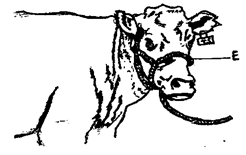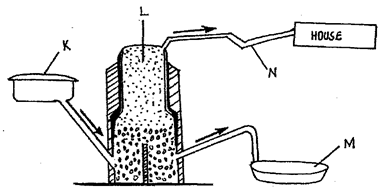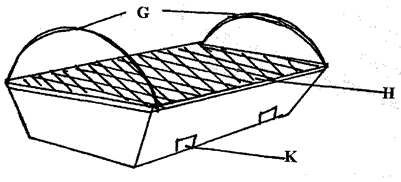- This paper consists of three sections; A, B and C.
- Answer all the questions in section A and B.
- Answer any two questions in section C.
- Candidates should answer all the questions in English.
SECTION A (30 marks)
ANSWER ALL QUESTIONS IN THIS SECTION IN THE SPACES PROVIDED
- Name four light breeds of poultry. (2mks)
- State four conditions necessary for egg incubation (2mks)
- Give four disadvantages of inbreeding. (2mks)
- Give four factors that a farmer may consider while carrying out culling in livestock production.(2mks)
- State four predisposing factors of pneumonia in lambs (2mks)
- Name four tools used in dehorning. (2mks)
- Give four general methods of controlling livestock diseases. (2mks)
- State four features of clean milk. (2mks)
- Name four factors to consider while choosing construction materials in the farm. (2mks)
- State four control measures of liver fluke (2mks)
- State four factors that influence the pulse rate of an animal. (2mks)
- Distinguish between the Saanen and Jamnapari breeds of goats. (2mks)
- Give four types of beehives. (2mks)
- State two ways of caponisation in poultry. (2mks)
- Name four disadvantages of battery cage system. (2mks)
SECTION B (20 MARKS)
ANSWER ALL THE QUESTIONS IN THIS SECTION IN THE SPACES PROVIDED.
- Study the diagram of a cow below and answer the subsequent questions.
- Identify the livestock equipment marked E above. (1mk)
- State two uses of the equipment in 17 (i) above. (2mks)
- Name the two types of identification marks applied on the animal above. (1mk)
- Show with an arrow and mark with letter P where pye-grease acaricide should be applied on the animal. (1mk)
- Study the illustration of a biogas digester plant and answer the questions that follow.
- Name the major component of biogas that is trapped in part L above. (1mk)
- Give the name of the material deposited in part labeled M and its use. (1mk)
name_______________________________________________________________________
Use_________________________________________________________________________ - What is the component of K in the biogas production? (1mk)
- Give three disadvantages of biogas as a source of farm power. (3mks)
- Below is a diagram illustrating a beehive? Study carefully an answer the questions that follow.
- Name the type of beehive shown (1mk)
- Name the parts labeled H and K (1mk)
H___________________________________________________________________________
K___________________________________________________________________________ - Give two importance of part G (2mks)
- Give two tools used for detaching honey combs during honey harvesting. (2mks)
- Study the diagram below f farm tools and equipment and answer questions that follow.
- Identify tool M and N (1mk)
M__________________________________________________________________________
N___________________________________________________________________________ - State one functional difference between M and N (1mk)
- State two maintenance practices of tool M. (1mk)
- Identify tool M and N (1mk)
SECTION C (40 MARKS)
ANSWER ANY TWO QUESTIONS FROM THIS SECTION IN THE SPACES PROVIDED AFTER THE SECTION.
-
- State four reasons for breeding cattle. (4mks)
- Explain four routine management practices carried out during rearing of dairy calves. (8mks)
- State five reasons for swarming in bees. (5mks)
- List three ways of controlling liver flukes in sheep. (3mks)
-
- Discuss the disease Trypansomiasis under the following sub headings.
- Causal organism (1mk)
- Animals attacked (1mk)
- Mode of transmission (1mk)
- Symptoms (2mks)
- Control (2mks)
- Explain six measures used in controlling diseases in livestock. (12mks)
- Discuss the disease Trypansomiasis under the following sub headings.
-
- Explain the management of growers in deep litter system until the time of laying (1mks)
- State and explain eight materials and equipment used during milking. (8mks)
MARKING SCHEME
- Name four light breeds of poultry. (2mks)
- sykes
- leghorns
- ancona
- minorcas
- State four conditions necessary for egg incubation (2mks)
- good ventilation
- appropriate temperature range
- high level of hygiene
- proper egg turning
- Give four disadvantages of inbreeding. (2mks)
- increase in pre-natal mortality rate
- reduces fertility
- reduces productivity
- loss of vigour
- Give four factors that a farmer may consider while carrying out culling in livestock production.(2mks)
- old age
- hysical defects
- reduced production
- susceptibility to diseases
- infertility
- poor mothering ability
- State four predisposing factors of pneumonia in lambs (2mks)
- overcrowding
- poor ventilation
- low level of hygiene
- age/young animals are vulnerable
- draught
- Name four tools used in dehorning. (2mks)
- hot iron
- rubber ring with elastrator
- dehorning wire
- dehorning colloidion
- Give four general methods of controlling livestock diseases. (2mks)
- proper selection and breeding
- proper housing
- control of parasite
- proper disposal of carcass
- observing high degree of hygiene
- treatment of sick animals
- State four features of clean milk. (2mks)
- have the required nutrient composition and right proportions
- free from bad oduor
- free from pathogens
- free from foreign materials
- white in colour
- Name four factors to consider while choosing construction materials in the farm. (2mks)
- durability of the material
- availability
- workability
- strength
- cost
- use of the structure
- State four control measures of liver fluke (2mks)
- draining swampy areas
- killing water snails physically
- burning infested pasture
- drenching affected animals with suitable deworming drugs
- State four factors that influence the pulse rate of an animal. (2mks)
- ill health
- physiological status
- environmental factors
- degree of excitement
- Distinguish between the Saanen and Jannappari breeds of goats. (2mks)
- saanen is while cream in colour with erect ears pointing forwards while jannapari is white /black in colour with drooping ears
- Give four types of beehives. (2mks)
- Traditional African log hive
- Kenya Top Bar Hive (KTBH)
- longstroth hive
- dadant
- State two ways of caponisation in poultry. (2mks)
- injecting the male chick with the hormone called stilboestrol
- inserting pellets of female sex hormone underneath the skin of the male chick.
- Name four disadvantages of battery cage system. (2mks)
- expensive
- bruising of comb and neck
- no exercise
- accumulation of parasites and diseases
SECTION B (20 MARKS)
ANSWER ALL THE QUESTIONS IN THIS SECTION IN THE SPACES PROVIDED.
- Study the diagram of a cow below and answer the subsequent questions.
- Identify the livestock equipment marked E above. (1mk)
- halter
- State two uses of the equipment in 17 (i) above. (2mks)
- restraining the animal during livestock handling
- guiding the animal using a lead stick
- Name the two types of identification marks applied on the animal above. (1mk)
- ear notching
- ear tagging
- Show with an arrow and mark with letter P where pye-grease acaricide should be applied on the animal. (1mk)
- along the dewlap
- Identify the livestock equipment marked E above. (1mk)
- Study the illustration of a biogas digester plant and answer the questions that follow.
- Name the major component of biogas that is trapped in part L above. (1mk)
- methane
- Give the name of the material deposited in part labeled M and its use. (1mk)
- name- slurly
Use- used as manure
- name- slurly
- What is the component of K in the biogas production? (1mk)
- dung and water
- Give three disadvantages of biogas as a source of farm power. (3mks)
- expensive
- Name the major component of biogas that is trapped in part L above. (1mk)
- Below is a diagram illustrating a beehive? Study carefully an answer the questions that follow.
- Name the type of beehive shown (1mk)
- Kenya Tp Bar Hive (KTBH)
- Name the parts labeled H and K (1mk)
- H- top bars
- K- hole
- Give two importance of part G (2mks)
- hanging the hive above the ground level
- allow the hive to swing in case of attack by
- Give two tools used for detaching honey combs during honey harvesting. (2mks)
- hive tool
- brush
- Name the type of beehive shown (1mk)
- Study the diagram below f farm tools and equipment and answer questions that follow.
- Identify tool M and N (1mk)
- M – Hack saw
- N- Rip saw
- State one functional difference between M and N (1mk)
- M is used for cutting metal while N is used for cutting wood (mark as a whole)
- State two maintenance practices of tool M. (1mk)
- repair/replace broken handles
- sharpen the teeth
- Identify tool M and N (1mk)
SECTION C (40 MARKS)
ANSWER ANY TWO QUESTIONS FROM THIS SECTION IN THE SPACES PROVIDED AFTER THE SECTION.
-
- State four reasons for breeding cattle. (4mks)
- expand inhented potential/improve inhanted potential
- introduce new genon
- satisfy consumer taste
- overcome production problems carried by environmental/improve production
- for economic reasons
- Explain four routine management practices carried out during rearing of dairy calves. (8mks)
- diseases control – calves vaccinated against infectious diseases
- parasite control – calves sprayed against ticks and other external parasites
- drenching against internal parasites
- Castration – male calves castrated for fasten fattening, controlling breeding, inbreeding and spread of (STI) Sexually Transmitted Infections.
- deteating – removal of extra vestigial teats to allow development of normal teats and avoid predisposing the animal to mastitis.
- dehorning/disbudding eg cutting of hours to reduce space requirement per animal, animal injuring each other and for docility
Mention of practice 4x1=4mks
Correct explanation 4x1=4mks
- State five reasons for swarming in bees. (5mks)
- shortage of food and water
- overcrowding
- bad smell
- outbreak of diseases and parasites
- sick queen/infertile queen
- damage of brood/combs
- inadequate ventilation
- List three ways of controlling liver flukes in sheep. (3mks)
- controlling fresh water snails
- draining swampy areas
- routine drenching of sheep
- burning infected pastures in dry reasons
- avoid grazing on water logged areas
- State four reasons for breeding cattle. (4mks)
-
- Discuss the disease Trypansomiasis under the following sub headings.
- Causal organism (1mk)
- protozoa
- Animals attacked (1mk)
- cattle, sheep, gats, pigs, houses
- Mode of transmission (1mk)
- vector borne by the tsetse fly
- Symptoms (2mks)
- intermittent growth
- straining coat
- anaemia
- abortion in females
- oedema
- enlarged lymph nodes
- loss of hair at the tail end
- Control (2mks)
- treat sick animals with trypanocidal drugs
- confine game animals in parks
- raise resistant breeds
- Causal organism (1mk)
- Explain six measures used in controlling diseases in livestock. (12mks)
- practicing general hygiene
- isolate sick animals to prevent spread
- deworm animals to control endoparasite
- treat animals to prevent spread of diseases
- vaccinate animals to give them resistance immunity
- control vectors to prevent spread of diseases
- routine administration of drugs
- use prophylactic drugs to prevent infestation
- proper rotation of breeding to control diseases
- proper housing to avoid predisposing factors of
- hoof trimming to minimize occurrence of foot to rot dnane
- imposing quarantine to prevent spread of diseases.
- mass slaughter of infected animals to prevent disease spread
- Discuss the disease Trypansomiasis under the following sub headings.
-
- Explain the management of growers in deep litter system until the time of laying (1mks)
- provide sufficient layers mash
- ensure feeders and waters are always clean
- hang soft green leaves to keep the birds busy
- scatter grains on the floor to keep the birds busy
- provide enough perches and waters
- collect eggs 2-3 times a day
- de-beak birds to prevent egg eating
- cull perpetual cannibals
- dust birds against external parasites
- drench against external parasites
- vaccinate against diseases
- provide enough litter
- cull poor layers
- isolate and treat sick birds
- dispose off dead birds
- State and explain eight materials and equipment used during milking. (8mks)
- strip cup
- drying towel
- filtering pads
- milking pail
- milking stool
- milk churn
- weighing scale
- milking machine
- Explain the management of growers in deep litter system until the time of laying (1mks)
Download Agriculture Paper 2 Questions and Answers - Asumbi Girls Highschool Pre-Mock Exams May-June 2022.
Tap Here to Download for 50/-
Get on WhatsApp for 50/-
Why download?
- ✔ To read offline at any time.
- ✔ To Print at your convenience
- ✔ Share Easily with Friends / Students





